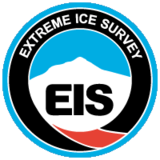 Extreme Ice Survey logo | |
| Founded | 2007 |
|---|---|
| Founder | James Balog |
| Purpose | Providing a visual baseline for demonstrating the effects of climate change |
Area served | World-wide |
| Method | Using cameras to record changes in glaciers to reveal how fast climate change is transforming large regions of the planet |
| Website | extremeicesurvey |
The Extreme Ice Survey (EIS), based in Boulder, Colorado, uses time-lapse photography, conventional photography and video to document the effects of global warming on glacial ice. It is the most wide-ranging glacier study ever conducted using ground-based, real-time photography. Starting in 2007 the EIS team installed as many as 43 time-lapse cameras at a time at 18 glaciers in Greenland, Iceland, Alaska, Canada, the Nepalese Himalaya (where cameras were installed at Mount Everest in 2010), and the Rocky Mountains of the U.S. The cameras shoot year-round, during daylight, at various rates. The team supplements the time-lapse record by occasionally repeating shots at fixed locations in Iceland, Bolivia, the Canadian province of British Columbia and the French and Swiss Alps. Collected images are being used for scientific evidence and as part of a global outreach campaign aimed at educating the public about the effects of climate change. EIS imagery has appeared in time-lapse videos displayed in the terminal at Denver International Airport; in media productions such as the 2009 NOVA Extreme Ice documentary on PBS;[1] and is the focus of the feature-length film Chasing Ice, directed by Jeff Orlowski,[2] which premiered at the Sundance film festival in Utah on January 23, 2012.[3] Major findings were published in 2012 in Ice: Portraits of the World’s Vanishing Glaciers by James Balog (Rizzoli Publishing).
- ^ “Extreme Ice” documentary
- ^ Bailey, Rob (December 16, 2011). "The 'Ice' man cometh ... from Staten Island". silive.com. Staten Island Advance. Retrieved December 17, 2011.
- ^ DeFore, John (January 25, 2012). "Chasing Ice: Sundance Film Review". The Hollywood Reporter.